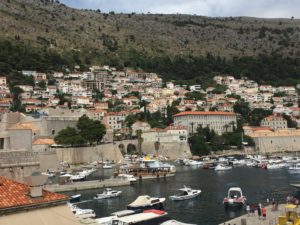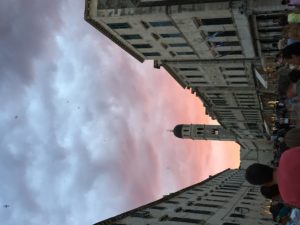June 29 – July 2
Dubrovnik captivated us!
Not sure what we were expecting exactly but Dubrovnik exceeded all expectations. Our first stop in Croatia, we were wide-eyed.
We employed a mix of pragmatism and inspiration, I think, when planning this trip; we weren’t just blindly poking the map. This culture drew us in – we had to know more, connect with the place, know what it means to be a local. We were excited for Croatia for good reason. Beauty, simple but strong cultural identity, Dalmatian coast, intriguing history, but beyond that we just came curious and open.
And enthusiastic.
From this stance we accept whatever Croatia and Dubrovnik have/had to offer; the natural state of things could just unfold.
That’s the best way to have a travel expectation, I believe; to not be aware you have framed a picture in the first place because you are diffusely focused on seeing things as they are, the broad landscape of it all, rather than as things should be from my own, lame mono-lingual perspective.
Must be one of the most alluring aspects of travel. It’s a time when I can be my most openly accepting of what is. Present moment richly saturated.
It also means you can be surprised.
It never occurred to me that our itinerary included somewhere where milk wasn’t. Milk is not that important to me. I noticed it wasn’t around. It’s not really in the market, which means that cheese (gasp!) and butter isn’t really part of the culture either. That was a surprise. We are in olive oil country, people. Not much of an issue. We were distracted with newness. It was young love. You don’t notice certain things in the early days of the relationship. That changed.
Once we got to little Komiza we settled in to being still. It wasn’t until our 7th day that we realized there weren’t any milk-making things (animals) anywhere on the little island. We are not counting the lactating stray cats.
Milk is brought in for the cafes who probably go through a ton of it trading in the cappuccino and gelato street markets but no one drinks it. No cows, no goats, no milk. The people of Komiza anyway, eat food like octopus and scorpionfish right out of the water in front of their house. We saw on occasion, men walking with a live octopus on a hook, like carrying a small prisoner, home to eat it fresh. Olive oil and a little bread, fresh veggies from someone’s little garden if not your own, that’s it! Gelato and lattes are for tourists.
Also surprising after 10 straight days of swimming in the Adriatic every single day, loving its crystal clear water and its deep and penetrating blues, was realizing on the 10th day that there are no waves. No waves. It’s not like any ocean swimming I’ve ever experienced. It’s the sea. Suddenly I get it. It’s more like a lake in that way. That’s how these houses could be built just feet from the water line. No jetties. No breakwalls. The world is full of surprises.
Dubrovnik has a quality that is hard to identify. It’s hard to get away from the mob of tourists for very long but it’s deeper. There is something of a fairytale feeling with the walled city perched on the edge of the sea, but there is also a gravity with their history of war. Dubrovnik itself was a fiercely independent republic for centuries, buying its sovereignty from surrounding entities. It could afford to do this due to its centuries-old strong trade industry and productive shipbuilding. It rivaled Venice. Those seeking to avoid or compete with Venice could do so in Dubrovnik. To this day there is a great sense of pride for the people of Dubrovnik around this historical certainty.
Libertas is carved in stone throughout the structures of old Dubrovnik. Another source of pride for the people of this city is their centuries-long attachment to the principle of liberty, freedom. Our AirBnB host, Jimmy, was eager to share that the Republic of Dubrovnik was the first foreign entity to recognize the newly formed United States in the late 1770s, celebrating the shared commitment to libertas.
Taylor and I keep processing the bits and pieces of 18th, 19th and twentieth century history of Croatia we are picking up. We are way under caffeinated these days to be really sharp about history 101. It’s all so complicated and heavily influenced by many wars. Fascinating influences of shifting powers, shifting markets as Dubrovnik lost some of its edge, invasions, WWI, the formation of Yugoslavia, WWII, a puppet state of the Nazis, the Yugoslav War, the dissolution of Yugoslavia…to its now EU membership status.
The Yugoslav war in the early 90’s made a ferocious hit on Dubrovnik, smacking down the audacity and pride, its ancient identity. Stone walls everywhere have bullet holes and tank blasts. Bright orange colored tile roofs indicate the areas of postwar rebuilding/reconstruction, nearly the entire city. Now driving through rural Croatia we see bombedout churches, barns and houses that have never been rebuilt, the former homes of Serbs who fled.
Everyone born in the early 90s or earlier has a story of how they lived through the war. Men we spoke with of our age were young officers who left young wives and small children in hiding. Given the atrocities of war, they felt nowhere would be safer for their wives and babies than their home city, even given the substantial bombardments.
Every Dubrovnik-an has some part of their cultural or national identity in that war, second only to their deeper and older identity of being from Dubrovnik. People growing up in the next nearest big city, Split, had relatively little direct war experience over the four years. Very different senses of identity in the different parts of Croatia.
Today, tourism is the nations only industry and it is starkly seasonal.
Cruise ships flood the old city of Dubrovnik daily. The city is attempting to manage the volume after years of allowing the cruise industry to dictate when thousands of tourists stream into an historically sensitive and limited-resource community.
Many Croatians recognize they owe a debt of gratitude to the cruise industry inspite of the infrastructure fatigue they feel. Celebrity Cruise was the first to make Dubrovnik a stop in 2001 when it was scrambling to rebuild after the Yugoslav war of the 90’s. In 2001, no hotels existed to accommodate the hoards from June to September so it worked out for 8 yrs; sleep on the ship, play in Dubrovnik. This brought desperately needed revenue in for the city and made possible their renewal. If 3 ships stop in one day, the usual is two, thousands of people flood Dubrovnik’s Old City and surrounding area for tours, beaches and restaurants. From 8am to 8pm, it’s show time.
Being a tour guide in Dubrovnik is taken very seriously. (I don’t think there are any tour guides in Komiza) There is a polish, a professionalism and sophistication that seemed to be the norm. Which, guess what that means – their English is almost as good as the Danes.
Because of their big ancient walls and business integrity (this seems to be an ancient attribute to this little republic) major movie industries have sought to do business here, utilizing their great tour guides and hospitality.
A few seasons of Game of Thrones have been filmed here so an entire niche of their tourism has evolved around that. You can take a Game of Thrones tour that walks you to the exact spots where scenes were filmed, places actors stayed during filming and cafes and restaurants the crew favored. Croatians loved being extras or filming support. Next to the yachting themed shops you can find specific shops with glossy posters, mugs, hats, t-shirts all with the Game of Thrones theme.
We met a man from Atlanta who was at a leadership conference in Serbia and made a special sidetrip with some colleagues to Dubrovnik for a Game of Thrones experience. Junkies exist everywhere.
Star Wars 8 was also filmed here (currently in editing) so once the movie is released a whole new facet of touring options with glossy brochures, t-shirts-mugs- and-hats and decaled minivans will erupt.
Croatians value good education but more Croatians are leaving, taking their good education and staunch work ethic with them, to make a living elsewhere. Leaves a country of old people and those that work in the tour and service industry. It will be interesting to see how the culture evolves from this point. The ever-important, wholesome, family-centric nature of this country will surely strain.
Croatia is catholic (part of the problem with Yugoslavia and a contributing factor for the war – Protestant, Muslim, Catholic). In fact, within the walled old city there were/are three diff catholic orders, Franciscan (pharmaceuticals), Jesuits (education) and Dominican (something Dubrovnik valued or they wouldn’t have been allowed in the city). There are archeological findings of 7th century cathedrals underneath the 3 existing churches inside the old city!
Unlike Bosnia, Serbia and Slovenia with their Muslim or Protestant faiths, Croatia reads more like an Italian country than a communist/eastern/ Slavic country. This is especially true in Dubrovnik and the north where Italy has the greatest impact. The years as a part of Yugoslavia and for most of the 20th century was spent as a communist country but there is little feel of that today – except for the fact that it seems under-developed and under-exploited. This is a warm, passionate and family-centric culture. That’s why it fought for its independence from Yugoslavia and why it doesn’t seem to have ever been permanently communist- their passion and warmth pervade.
They proport to have no crime.
We saw a few underemployed older individuals, very few. A few cafes turn in to bars at night but there is no thumpin, gyrating, oversexed pick up scene even though there are a lot of 20- and 30-somethings. Someone explained that no one wants to marry someone they meet in a bar. There is little draw to the bar scene unless it’s just to spend time connecting with friends. And that’s the vibe, friends connecting, not a sexual tension of flaunting and strutting. That still stuns me. I think it is what I am coming to see that I love about Croatia – it’s wholesome. For example, I cannot tell you how many grandFATHERS I have noticed with little toddlers. (Probably because everyone else in the family is working in the tourist industry!)
Kindness and a relaxed affability meet us everywhere we go (still trying to not raise our American voices). No trash to speak of, like you would expect for a Disneyland-like volume of tourists. Not very forward on recycling but very proud of its certified clean water (AND THIS IS NO JOKE! It will be an indelible part of our memories of Croatia!) and immaculate beaches (except for the fact that their beaches are stone…serious stone beach business, not for pansies). Not sure about the trash dump on the Island of Vis, however, but I guess they are allowed to have some growing pains.
We still have more time planned in Croatia, moving north and inland in a rental car to a National park and then over to the coast in the north. Before taking a ferry over to Venice, our last Croatian stop is Rovinj in the region/state of Istria which is known for its “atmospheric ” community, which we are taking to mean cool.
I’m formulating something around this proud history that is akin to Texas. I heard someone once say that Texans are Texans first, Americans second. Having been in other Croatian cities since leaving Dubrovnik I see that there is a similar dynamic with Dubrovnik’s national pride. Dubrovniks go to Zagreb (such as for training or university) or they leave the country, but they never stop being a Dubrovnik-an. Other Croatians do not move to Dubrovnik readily, even given the draw of the tourist industry.
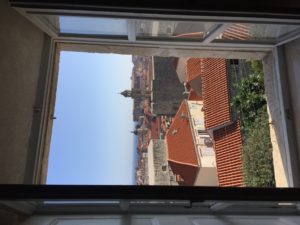
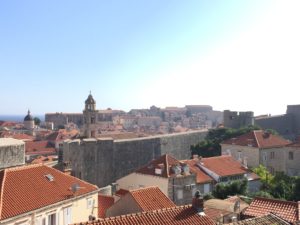

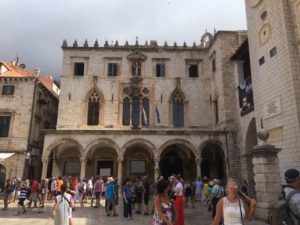
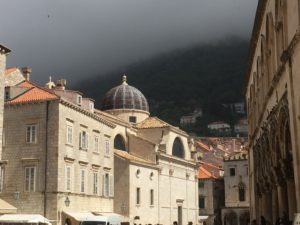
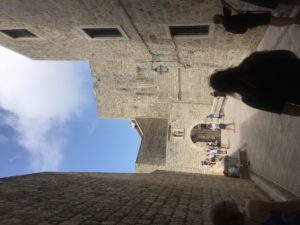
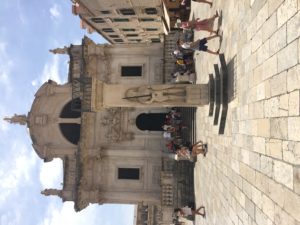
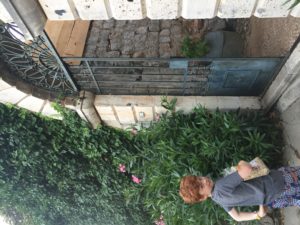
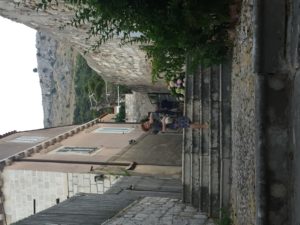
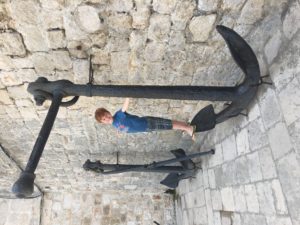
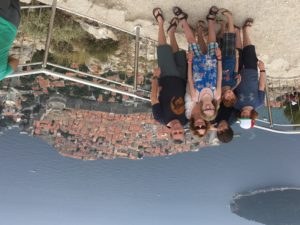
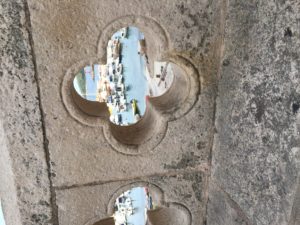
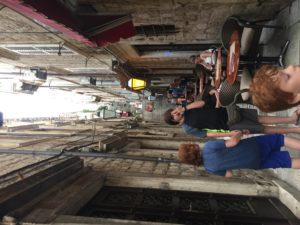
These narrow alleys are commonly used for cafes and restaurants. The floors up above are homes. Location of your home in ancient Dubrovnik was based on your livelihood. That’s not uncommon in European cities. None of us can remember this exactly but it went something like bankers and blacksmiths (and other shipbuilder jobs?) had to live closest to the city center for quick access by the powers that be.
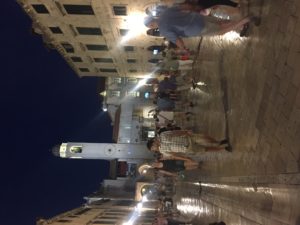
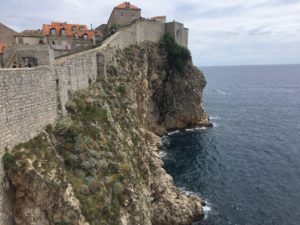
Walled city from the sea. Totally impressive and the views of the city from up there were just as amazing as those out to sea. Tiny ants on top are tourists. It takes 2 hours to walk the 8′ wide pathway (lots of ancient stairs that were not made to ergonomic standards), and of course some money. We paid the equivalent of $80US to be able to sweat and whine… and live like a local, walking along the top of that wall for 2hours.
